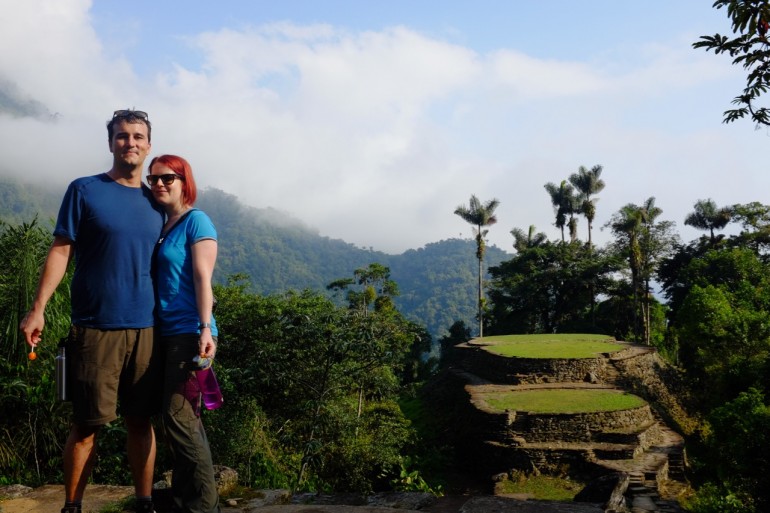Skip to photos here. There is a trek in the Northern part of Colombia: a 50km round trip in the Sierra Nevada mountain range near the Colombian coast that leads you to Ciudad Perdida, a “lost city” in the middle of the jungle. We love seeing things that are only accessible by foot, and the reviews suggested this would be a challenging trek, so it sounded perfect for us.
With Phil’s visiting sister Stephanie we flew to Baranquilla, and taxied to Santa Marta, a charming city in the Caribbean region. There, we met up with the five other members of our group − from England, Scotland, Australia, and Germany − and were driven to small town of Macheté, where the hike starts. Thirty minutes into hiking, we stopped for the first time to take a dip in a swimming hole: the crystal clear water of the Rio Buritaca. Over the next few days, we would take more swims whenever the river was accessible, always a real relief after hiking.
The first day of any trek, no matter how hard, is always the most difficult for me: I always get the feeling that my body is screaming, asking me why the hell I’ve opted for trekking over sitting poolside with a drink in hand. Headed towards Ciudad Perdida, Day 1 was particularly challenging because it involved a grueling ascent in the intense heat. The views from the top, green for as far as you could see, more than made up for that though, and we happily arrived at our first camp, a simple shelter with hammocks. In the nights following, our camps had bunk beds and mattresses, and all of the camps – while basic – had running water and showers, as well as hammocks and beds outfitted with mosquito nets… so much more than we had expected. 😀
If it had been raining and we’d have had to make our way through fiercely flowing rivers or hike up muddy hill slopes, this would have qualified as a “hard trek.” But as it was, we had marvelous weather throughout our four days, and the streams we had to pass over were easy to cross. Neither Phil nor I found this trek to be as tough as advertised, and agreed that this was do-able if you’d ever hiked or trekked a bit and had the right equipment (read: sturdy walking shoes). Beyond the weather and the fun people in our group, we also got lucky with the cook who joined us. Food is usually good when you have been hiking all day, but the dishes he whipped up would have been quite good under any conditions.
Throughout our time hiking, our guide Levi kept a pace that worked well for all of us, making occasional stops to distribute fruit snacks; Fresh slabs of watermelon, oranges, pineapple… just taste so much better when you’re in sweaty-hiker mode and the fruit juice mixes in with your salty sweat. As anyone who has ever hiked with me can attest, I have an uncanny ability to sweat. It isn’t pretty… to say the least, but I like to think it’s healthy,
The night before we hiked up to the lost city Levi told us all about the Kogi, the indigenous people whose territory we were in, where each man, once he reaches maturity, receives a “poporo” from the “mama,” the tribal and spiritual leader. A poporo is a container for powder from burned seashells, made from a pumpkin. With a stick, the Kogis consume the powder while they chew cocoa leaves, the mix acting as a stimulant. The poporo is considered an essential to a man, and we seldom saw a Kogi without poporo in hand. Women get the shorter end of the stick (or no stick in this case). They neither get a poporo, nor are they allowed to taste their husbands’. They just have to collect the coca leaves. I honestly hope I never end up being a Kogi lady in one of my next lives.
On our third day we got up at 5 am, enjoyed an arepa and egg breakfast, and headed up towards Ciudad Perdida just as the sun was starting to shine. I may have been a bit tired, or just too excited about reaching the top, but about ten minutes in, I stumbled over a big root and took an annoying fall. Even with my reasonably high pain threshold, the fall hurt like hell. But as the initial rush of adrenaline convinced me that I was fine, the ascent up 1200 un-even and moss-covered steps went well. We were the first group to arrive and were in awe of the sheer beauty we encountered: some 20 circular, grass-covered stone terraces, built by the Tayrona people around 800 AD, well before Macchu Picchu! Little is known about this site, and while there are thought to be upwards of 200 terraces in the area, the others remain unexcavated. It was easy to understand how this place had been lost to nature.
According to our guide, the site was abandoned around the time the of the Spanish invasion, and kept a secret only the indigenous people knew. It was “re-discovered” by “guaqueros” (gold hunters) in the 1970s, and finally came under government protection in 1976. A definite no-go territory for many years, there is now a military camp at the top of the Lost City and a large group of soldiers patrolling and ensuring its continued security.
After an hour of marveling at this amazing site, we started back down towards our last camp. The pain in my foot started getting really bad all of a sudden, and my foot was swollen. It looked like I might have to hire a mule to get back to the camp: Some people did the whole trek that way, and the idea made me cringe. I decided to take my chances, swallowed a moderate overdose of Ibuprofen and hobbled on. One of the people in our group also had a great foot support, which I was able to borrow, along with a walking stick from one of the guides.
A day later, we arrived back in Macheté, the starting point of the hike. We’d spent four sweat-stained days moving from one camp to the next, and having enjoyed a truly magical place, without being bitten by too many mosquitos. I can’t begin to explain how bad I smelled when we got back to civilization, and at the same time it’s hard to express the satisfaction we have in finishing one of those little adventures. My foot returned to normal within 48 hours (which we spent relaxing at the marvelous Finca Barlovento), and we are already looking forward to our next outing.

